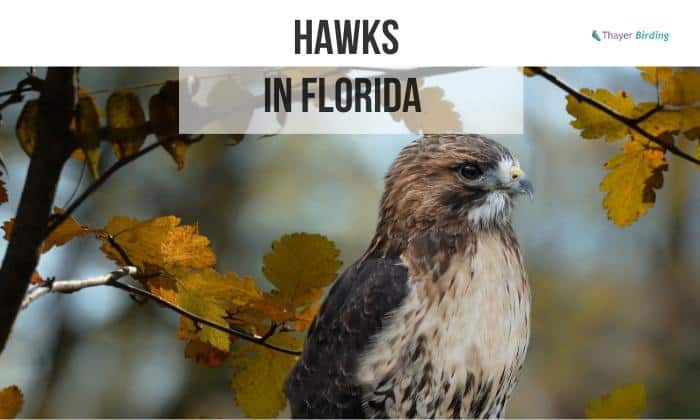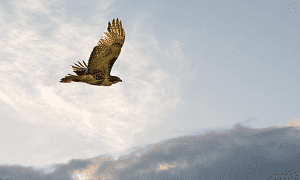There are beaches in Florida, and there are hawks and falcons in Florida.
These medium-to-large birds can be seen soaring over forests, grasslands, and occasionally even residential areas of the Sunshine State. But which species are 0commonly seen?
The seven common hawks in Florida are the Red-shouldered Hawk, Cooper’s Hawk, Red-tailed Hawk, Short-tailed Hawk, Broad-winged Hawk, Sharp-shinned Hawk, and Northern Harrier.
However, six species are “accidental” or only occasionally spotted, which include the Swainson’s Hawk and Ferruginous Hawk.
Table of Contents
7 Common Hawks in Florida
There are seven types of hawks in Florida. While most live in parts of the state year-round, some only come in the winter.
Here is a rundown of all seven, with pictures of hawks.
1. Red-shouldered Hawk (Buteo lineatus)
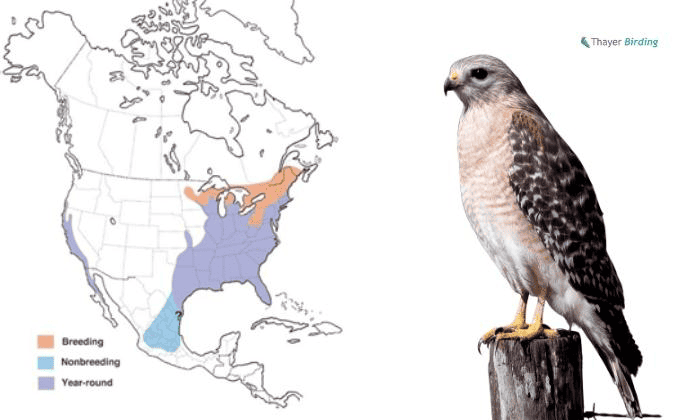
- Common Name: Red-shouldered Hawk
- Scientific Name: Buteo lineatus
- Average Size: 17-24 inches
- Average Wingspan: 37-43 inches
- Life Span: 20 years
- Status: Least Concern
- Presence in Florida: Year-round
Red-shouldered hawks are the most common hawk species across Florida year-round, which are medium-sized raptors 17-24 inches long, with a typical wingspan between 37-43 inches.
Their “red shoulders” refer to their reddish upper outer wing feathers. Additionally, they have a barred reddish chest and black-and-white streaked wings and tails.
These hawks are found in forests and swamps with open upper canopies. Their diet primarily consists of small mammals, reptiles, and amphibians.
These hawks are loyal creatures of habit that mate for life and reuse nests from prior years.
Though their conservation status is currently a species of least concern, these hawks’ most significant threat is habitat loss.
2. Cooper’s Hawk (Accipiter cooperii)
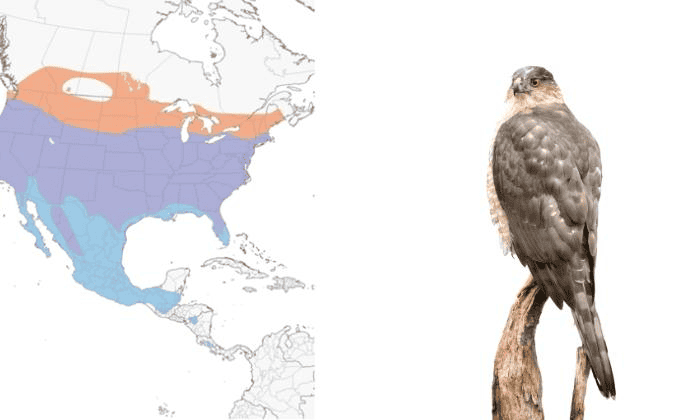
- Common Name: Cooper’s Hawk
- Scientific Name: Accipiter cooperii
- Average Size: 14-20 years
- Average Wingspan: Up to 36 inches
- Life Span: 8 years
- Status: Least Concern
- Presence in Florida: Year-round
Cooper’s Hawks are forest dwellers occasionally found in urban areas. They are 14-20 inches long with a wingspan of up to 36 inches.
These hawks have dark brown backs and white undersides with plenty of dark brown streaked spots. Their tails and wings have horizontal bars across them.
They are excellent, aggressive hunters, preying on chipmunks, squirrels, starlings, blackbirds, and even farm chickens. They are also known to have 40 unique hunting calls!
Because of their impressive agility and skill, people have given the hawk many nicknames, including Chicken Hawk, Flying Cross, and Swift Hawk.
3. Red-tailed Hawk (Buteo jamaicensis)
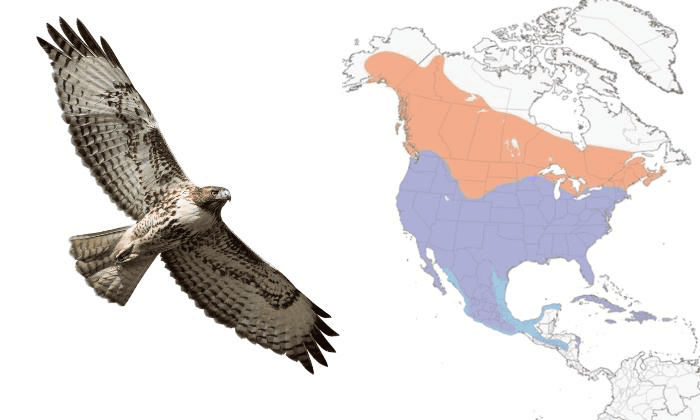
- Common Name: Red-tailed Hawk
- Scientific Name: Buteo jamaicensis
- Average Size: 18-26 inches
- Average Wingspan: 56 inches
- Life Span: 10-15 years
- Status: Least Concern
- Presence in Florida: Year-round
Red-tailed hawks, or simply red-tails, are native to Florida and can be found year-round. They are one of the largest hawk species, typically 18-26 inches long, with an enormous wingspan of up to 56 inches.
Their large wings enable these species to do “kiting” or remain mostly stationary in the air, held up solely by the wind beneath their wings.
Their appearances vary widely across North America; some appear primarily white, while others are mostly black. However, they all have distinct red tail feathers and the same 2-3 raspy “scream-like” call.
These hawks can adjust to almost any habitat but prefer forests with tall trees or areas with tall cliffs. What do Florida hawks eat? They mainly eat small mammals and rodents but may also eat reptiles, birds, amphibians, and fish, particularly when younger.
The Sunshine State is proud to have its own subspecies: the Florida red-tailed hawk.
4. Short-tailed Hawk (Buteo brachyurus)
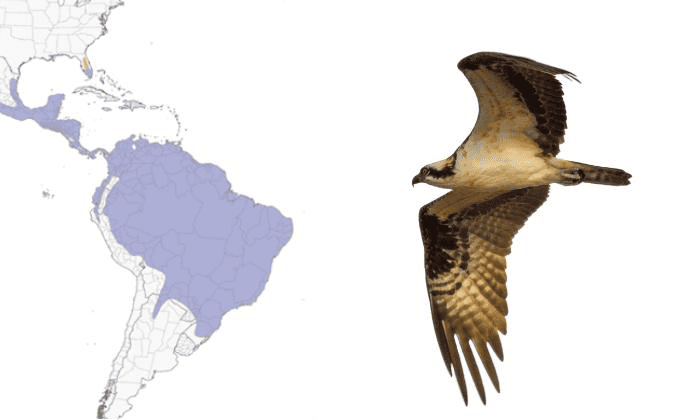
- Common Name: Short-tailed Hawk
- Scientific Name: Buteo brachyurus
- Average Size: 15-17 inches
- Average Wingspan: 32-40 inches
- Life Span: 20 years
- Status: Least Concern
- Presence in Florida: Year-round
Short-tailed hawks are small hawks, typically 15-17 inches long, with a wingspan of 32-40 inches. In other words, they are more or less the size of crows. They come in dark and light morphs, the only difference being the shade of brown on their backs.
These hawks primarily live in the woodlands of Southern Florida but sometimes migrate north to Central Florida for breeding. There are only an estimated 500 short-tailed hawks in the state.
These birds mainly hunt in the air, snatching songbirds and smaller hawks (such as the sharp-shinned hawk) as meals. However, they occasionally also eat small rodents, reptiles, and amphibians.
5. Broad-winged Hawk (Buteo platypterus)
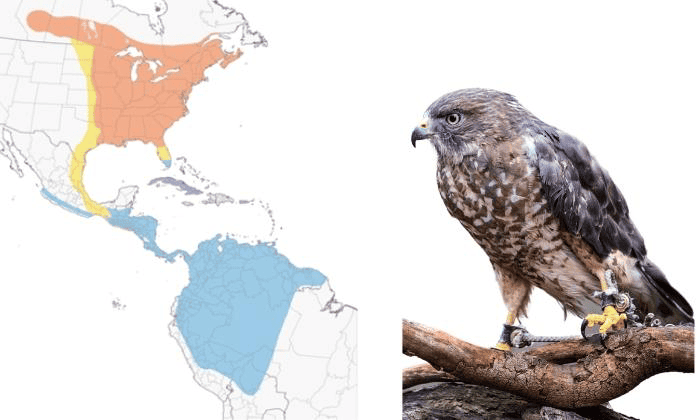
- Common Name: Broad-winged Hawk
- Scientific Name: Buteo platypterus
- Average Size: 13-17 inches
- Average Wingspan: 29-39 inches
- Life Span: 12 years
- Status: Least Concern
- Presence in Florida: Spring and summer, North Florida; Fall, Central Florida; Winter, South Florida
Broad-winged hawks are between 13-17 inches long with a vast wingspan of 29-39 inches. They have dark brown backs, and bodies streaked with white, while their undersides feature an opposite coloring of white with brown markings.
These hawks are very vocal, frequently making sound to communicate with family and scare away intruders to their territory. Young month-old hawks are already able to make these sounds!
Broad-winged hawks thrive in forests, wetlands, and meadows at high elevations of around 6,600 feet but occasionally approach residential areas. They are opportunistic carnivores that enjoy small mammals, birds, reptiles, amphibians, and insects.
Source
6. Sharp-shinned Hawk (Accipiter striatus)
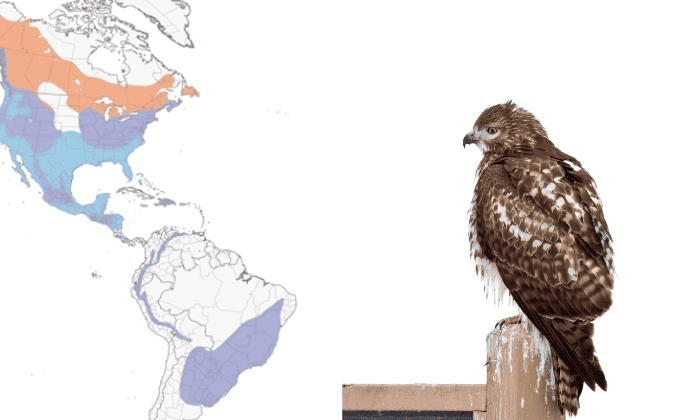
- Common Name: Sharp-shinned Hawk
- Scientific Name: Accipiter striatus
- Average Size: 9-14 inches
- Average Wingspan: 22 inches
- Life Span: 3-13 years
- Status: Least Concern
- Presence in Florida: Winter (October to March)
Sharp-shinned hawks are the smallest hawk in Florida and the United States. Also known as “sharpies,” these hawks are only 9 to 14 inches long with a wingspan of up to 22 inches, making them slightly larger than jays but smaller than crows.
These hawks have long, slender legs, which inspired scientists to give it its name. They have white undersides heavily streaked with reddish-brown spots and bars, dark brown backs, and brown heads with hooked black bills.
These hawks are typically found in forests but are frequent visitors to residential area bird feeders. They enjoy a diet of small rodents, reptiles, amphibians, mammals, and even other birds.
Related: Sharp-Shinned Hawk vs Cooper’s Hawk.
7. Northern Harrier (Circus hudsonius)
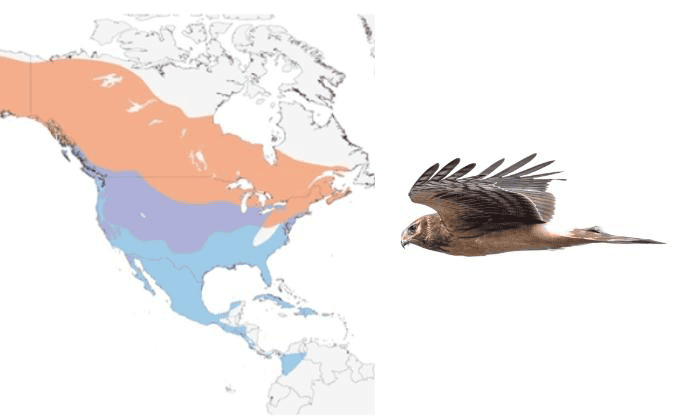
- Common Name: Northern Harrier
- Scientific Name: Circus hudsonius
- Average Size: 16-20 inches
- Average Wingspan: 45 inches
- Life Span: 15 years
- Status: Least Concern
- Presence in Florida: Winter (September or October to April)
Northern Harriers are birds of prey in Florida only in the winter, beginning September or October until April. They migrate north during the warmer months for breeding.
These hawks are 16-20 inches long with an average wingspan of 45 inches. However, what distinguishes them the most from all other hawk species is their flat, owl-like face!
This facial structure gives Northern Harriers sharp hearing, which enables them to easily hunt their preferred prey of small mammals such as rats, squirrels, and voles.
This hawk species is most commonly spotted in fields and marshes in the wild, gliding lightly along the wind. These features have led to the hawk’s two nicknames, Marsh Hawk and Gray Ghost.
6 Accidental Hawk Species in Florida
Aside from Florida’s seven regular hawk species, six are not truly residents but are spotted on rare occasions.
1. Swainson’s Hawk (Buteo swainsoni)
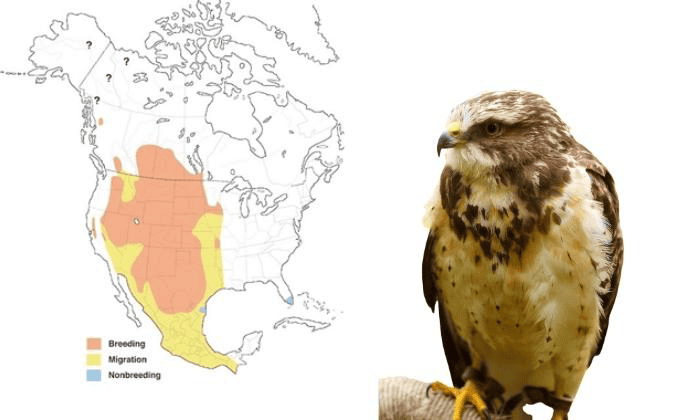
- Common Name: Swainson’s Hawk
- Scientific Name: Buteo swainsoni
- Average Size: 20 inches
- Average Wingspan: 50 inches
- Life Span: 7-8 years
- Status: Least Concern
- Presence in Florida: Rare
Swainson’s hawks are also known as grasshopper or locust hawks because they love munching on these insects. They are typically found in open areas such as grasslands, deserts, and prairies.
These hawks are 20 inches long with a 50-inch wingspan, on average. Most Swainson’s hawks have light undersides, reddish upper chests, and brown backs. However, a tiny percentage are completely dark-brown except for a light patch under the tail.
Swainson’s hawks typically migrate to South America, particularly Argentina and Brazil, for the winter. However, some are content to spend the cold months in South Florida.
2. Great Black Hawk (Buteogallus urubitinga)
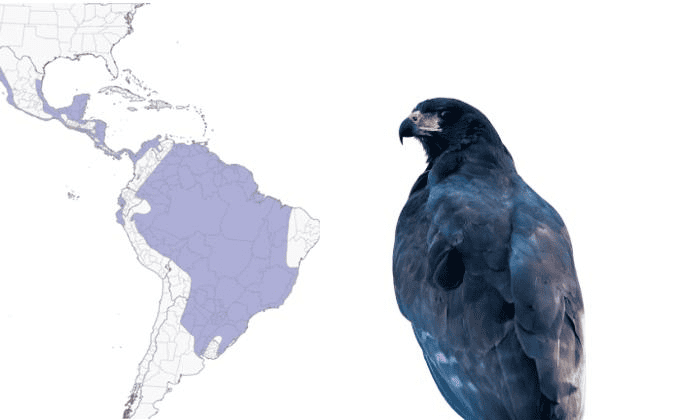
- Common Name: Great Black Hawk
- Scientific Name: Buteogallus urubitinga
- Average Size: 22-25 inches
- Average Wingspan: 47-54 inches
- Life Span: No available information
- Status: Least Concern
- Presence in Florida: Rare
Great Black Hawks live mainly in coastal areas and forests in Central and South America. Sometimes, though, it flies northward and can be spotted in southern US states, including Florida.
The medium-sized hawk is 22-25 inches long with broad wings and is often confused with the common black hawk. However, the Great Black is larger than the Common Black, has a broader white stripe on its tail, and has a different call.
The hawk is an omnivore that enjoys nearly everything, from reptiles, fish, birds, small rodents, and insects, to fruit, eggs, and carrion.
3. Zone-tailed Hawk (Buteo albonotatus)
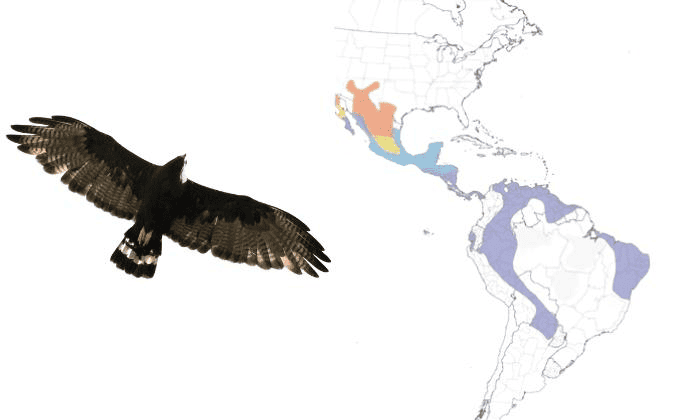
- Common Name:Zone-tailed Hawk
- Scientific Name: Buteo albonotatus
- Average Size: 20 inches
- Average Wingspan: 46-55 inches
- Life Span: 25 years
- Status: Least Concern
- Presence in Florida: Rare
Zone-tailed hawks are nearly all-black except for dirty white streaks under their wing feathers and white bands (or “zones”) across their tails. On average, they are 20 inches long with a wingspan of 46-55 inches.
These hawks live in South America year-round but occasionally travel north, reaching Utah, Colorado, New Mexico, and Texas to breed. Sometimes, they take side trips to Florida!
Their preferred habitat is rocky areas close to water. However, they are adaptable birds living in nearly any environment, from forests to marshes and canyons.
Zone-tailed hawks eat whatever is available in their habitat, including small mammals, insects, reptiles, amphibians, and even small birds.
4. Northern Goshawk (Accipiter gentilis)
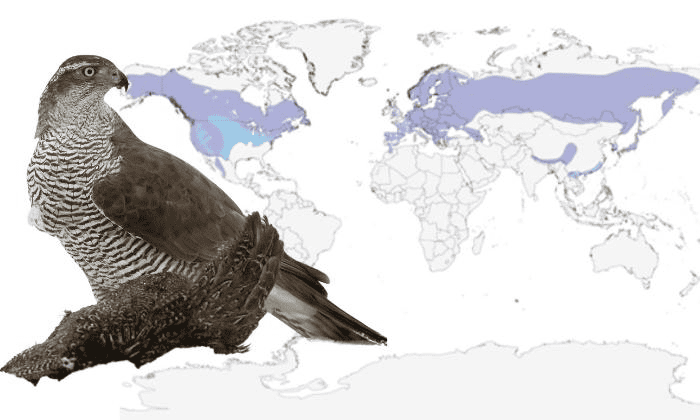
- Common Name: Northern Goshawk
- Scientific Name: Accipiter gentilis
- Average Size: 21-25 inches
- Average Wingspan: Up to 46 inches
- Life Span: 15 years
- Status: Least Concern
- Presence in Florida: Rare
Northern Goshawks are majestic birds typically 21-25 inches long with a wingspan of up to 46 inches. They are the largest hawk species in Europe.
They are mainly found in the northern part of the North American continent, across Canada, Alaska, and northern US states. However, they migrate to the south toward central North America in the winter, occasionally reaching as far as Florida.
These brown hawks live in forests and hunt small mammals and birds. They can fly as fast as 37 miles per hour on a chase!
Because of their appearance, Northern Goshawks are often confused with Cooper’s Hawks, but Cooper’s Hawk is much smaller.
5. Ferruginous Hawk (Buteo regalis)
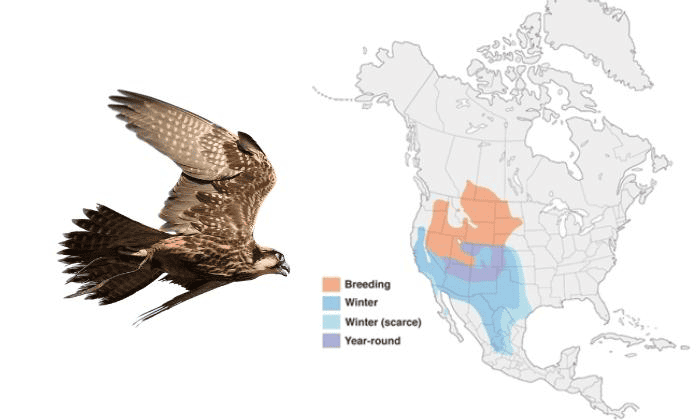
- Common Name: Ferruginous Hawk
- Scientific Name: Buteo regalis
- Average Size: 22-27 inches
- Average Wingspan: 52-56 inches
- Life Span: 12 years
- Status: Least Concern
- Presence in Florida: Rare
Ferruginous Hawks are the largest hawk species in North America, with a body length of 22-27 inches and a massive wingspan of 52-56 inches. Because of its size, it’s often mistaken for an eagle.
These hawks often have white undersides and heads with brown backs and upper wings. However, they may also come in darker morphs with brown undersides, only displaying white feathers on the tips of their wings and tail.
Ferruginous Hawks are more common in the northwestern States, living in Arizona, New Mexico, Utah, and Colorado year-round. They live in grasslands and shrublands, thriving on a diet of small mammals.
Floridians have reported spotting Ferruginous Hawks in their state on rare occasions now and then since 1986.
6. Rough-legged Hawk (Buteo lagopus)
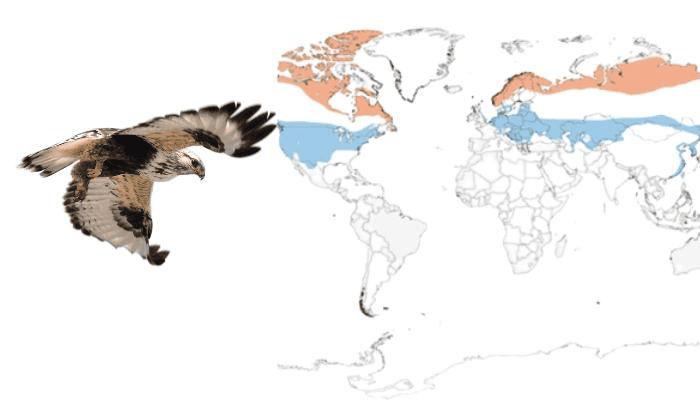
- Common Name: Rough-legged Hawk
- Scientific Name: Buteo lagopus
- Average Size: 20 inches
- Average Wingspan: 54 inches
- Life Span: 2 years
- Status: Least Concern
- Presence in Florida: Rare
Rough-legged hawks are occasionally called rough-legged buzzards (in Europe) or rough-legged falcons in Florida. They are large birds up to 20 inches long with a wingspan of up to 54 inches.
Their “rough legs” refer to the feathers on their legs, which help keep them warm in their natural habitat up north. However, they are a migrating species that fly south in the winter, rarely making it to Florida.
These hawks live in tundra and boreal forest habitats but can also be seen in marshes and prairies. They are carnivorous, with a diet primarily consisting of small mammals such as lemmings and voles.
Rough-legged hawks build unique nests that are sometimes lined with bones!
Migration Patterns and Behavior
Most but not all hawks migrate. What factors cause these birds to journey hundreds and even thousands of miles?
1. Season Migration of Hawks
Big flocks of hawks called “kettles” are usually seen crossing North America between September and November and again in March and April.
Hawks use visual cues such as familiar landmarks to orient themselves while traveling. However, they are also sensitive to Earth’s magnetic field, which they use to ensure they go the right way!
Primarily, hawk migration is linked to the seasons–but it’s not often about the cold. Red-tailed hawks, for example, can tolerate freezing temperatures well.
Hawks migrate to warmer regions during winter, where more food will be available. These are sometimes referred to as their “wintering grounds.”
After the cold months, they migrate back north to reach their natural breeding grounds to mate and build a family.
2. Factors That Influence Migration Patterns
Four main factors influence hawk migration patterns and timing. These are
- Weather – Like human drivers, birds need good visibility to see where they are going. Hawks prefer to undertake their journey with clear skies and light winds. They will never start their flight during a storm!
- Food – Hawks cannot carry food with them as they migrate. Therefore, they stick to paths where they know they can find prey and water to sustain them on their journey. This is why most birds fly along open fields and coastlines.
- Breeding conditions – Hawks migrate when they know it is time to breed. This is often triggered by their environment, particularly temperature and day length changes.
- Climate change – Climate change strongly affects hawks’ migration patterns. They may leave earlier or later than usual, depending on their the environment’s temperature and day length. Some may choose to cut their journey short or not migrate at all, content with the warmth of their natural habitat even during winter.
Conclusion
If you live in Florida, you don’t have to visit the zoo to see these beautiful raptors. There are numerous wild hawks in Florida at different times of the year and in different areas.
It can be tricky to spot these birds when they are flying high, but you may be lucky and catch a glimpse of their striking feathers or hear their piercing calls.
If you haven’t yet, consider watching a hawk migration. This is a breathtaking sight that everyone should see at least once in their life!
Read next: Falcons vs Hawks: What’s the Difference?

George and I became friends after a birdwatching trip with our new group. And we have been enjoying every adventure together. When he told me the idea of establishing a site that shares our experiences and fun, I immediately agreed. After trials and errors, here we have Thayerbirding.


